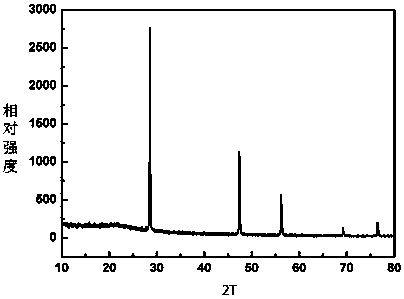A kind of preparation method of silicon carbon composite material
A technology of silicon-carbon composite materials and compounds, applied in structural parts, electrical components, battery electrodes, etc., can solve the problems of limiting the mass production of silicon-based materials, material shape changes, and poor cycle performance, and achieve poor electronic conductivity , low cost and small capacity loss
- Summary
- Abstract
- Description
- Claims
- Application Information
AI Technical Summary
Problems solved by technology
Method used
Image
Examples
Embodiment 1
[0018] Dissolve 10g of glucose and 6g of polyvinylpyrrolidone (K30) in 60mL of water, then add 0.3g of high-purity nano-scale silicon powder (Cas: 7440-21-3), and transfer the mixture to a closed reaction kettle. After reacting for 5 hours, a columnar gel was obtained after the reaction. figure 1 (a), the gel was freeze-dried and then calcined at 1200°C for 3 hours under a nitrogen atmosphere to obtain a silicon-carbon composite material. The powder diffraction pattern is shown in figure 2 , see the transmission electron micrograph image 3 .
Embodiment 2
[0020] Dissolve 5.5g of sucrose and 0.5g of polyacrylamide (Mw: 2000000-14000000) in 20mL of water, and then add 0.6g of high-purity nano-scale silicon powder (Nano-Si powder, Hefei Kaier Nano Technology Development Co., Ltd.). The mixed solution was transferred to a closed reaction kettle and reacted at 200°C for 5 hours. After the reaction, a cylindrical gel was obtained. See figure 1 (b), the gel was freeze-dried and calcined at 1000°C for 2 hours under a nitrogen atmosphere to obtain a silicon-carbon composite material.
Embodiment 3
[0022] Dissolve 5g of lactose and 0.6g of polyacrylamide (Mw: 2000000~14000000) in 15mL of water, then add 10mL of acetic acid and 0.9g of high-purity nano-scale silicon powder (Nano-Si powder), and transfer the mixture to a closed reaction kettle , and reacted at 200°C for 5 hours. After the reaction, a columnar gel was obtained. After the gel was freeze-dried, it was calcined at 1000°C for 4 hours under a nitrogen atmosphere to obtain a silicon-carbon composite material.
PUM
 Login to View More
Login to View More Abstract
Description
Claims
Application Information
 Login to View More
Login to View More - R&D
- Intellectual Property
- Life Sciences
- Materials
- Tech Scout
- Unparalleled Data Quality
- Higher Quality Content
- 60% Fewer Hallucinations
Browse by: Latest US Patents, China's latest patents, Technical Efficacy Thesaurus, Application Domain, Technology Topic, Popular Technical Reports.
© 2025 PatSnap. All rights reserved.Legal|Privacy policy|Modern Slavery Act Transparency Statement|Sitemap|About US| Contact US: help@patsnap.com



